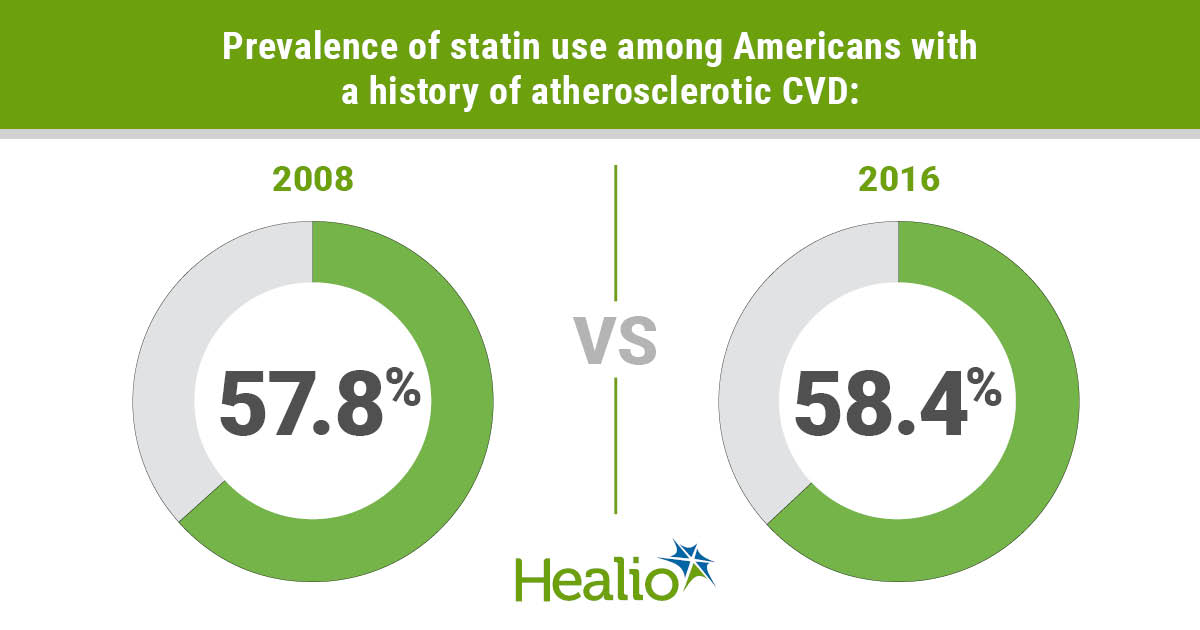Two keys to improving statin adherence: Communicate, simplify regimens


Some in the medical community were initially skeptical of the first statin to win FDA approval, according to a history of the medication published in Heart Views. Now, 32 years later, research suggests it is patients who are reluctant to fully embrace statin use.
For example, a study published last year in the Journal of the American Board of Family Medicine showed that the prevalence of statin use among Americans with a history of atherosclerotic CVD plateaued — from 57.8% in 2008 to only 58.4% in 2016. The researchers noted that concerns about adverse events and prolonged dependence on the medication may be among the reasons patients are hesitant to use statins.
Eugene Yang, MD, a member of the American College of Cardiology’s Prevention of Cardiovascular Diseases Council, told Healio Primary Care that the findings are not surprising.
“But they are disappointing,” he said. “The fallout rate among patients who take statins tends to be very high.”

To commemorate American Heart Month, Healio Primary Care explored two important ways that primary care physicians can improve statin uptake among their patients.
Conversations have ‘enormous potential’
In an interview, Yang stressed the importance of having open lines of communication with patients about statins and being prepared to field detailed questions.
“Patients have access to more information than in the past,” he explained. “This prompts their own questions about studies’ merits and conflicts of interest in the pharmaceutical industry. While this is not a bad thing, clinicians must work harder to overcome patients’ preconceived notions about the risks vs. the benefits of these treatments.”
Yang, who is also co-director of the University of Washington Medicine Cardiovascular Wellness and Prevention Program, said that clinicians should put statin therapy in context for patients.
“We know that about two-thirds of patients with diabetes will die of CVD,” Yang said. “When patients learn that statins can help patients with diabetes reduce their risk for heart attack or stroke, that probably helps push more patients to seeing the medication’s benefits than focusing on the potential side effects.”
Patricia Maningat, MD, MSc, a visiting fellow at The Rockefeller University, and colleagues discussed the "enormous potential" that patient-physician communication has on improving patient adherence. In Current Atherosclerosis Reports, they recommended that physicians ask nonjudgmental questions about patients’ medication adherence.
“If a patient admits to nonadherence, he/she is usually telling the truth, but if a patient denies nonadherence, he/she is telling the truth about half the time,” they wrote.
In Cardiovascular Drugs and Therapy, experts suggested that patients are more likely to adhere to therapy if physicians provide details about statins’ efficacy, their pharmacokinetic profile, their adverse events and how long the patients will need to take them.
Yang and Quyen Ngo-Metzger, MD, MPH, a former U.S. Preventive Services Task Force scientific director and a co-author of the 2019 JABFM study, both encouraged the use of visual aids to help patients understand the benefits of statin use.
“The Mayo Clinic has a decision aid called Statin Choice,” Ngo-Metzger explained. “Clinicians can put in a patient’s BP levels, smoking history and diabetes history. The tool uses a variety of risk calculators created by the American Heart Association and American College of Cardiology to determine their heart attack risk.”
Other discussions should center around muscle pain or any other adverse events that may lead to patients discontinuing statin use, Ngo-Metzger continued.
Polypill: An ‘effective strategy’
Another approach to improving adherence is simplifying the patient’s regimen.
In 2014, two separate randomized controlled trials demonstrated that patients who were given a fixed-dose combination treatment to prevent cardiovascular disease — including statins, BP-lowering drugs and sometimes aspirin — had better adherence than those who took the drugs separately. Findings from two additional randomized controlled trials published last year also support the polypill approach.
Barry L. Carter, PharmD, professor emeritus at the College of Pharmacy at the University of Iowa, said polypill formulas might be worth pursuing, but there is an important caveat: price.
“Fixed combination pills have been shown to increase adherence as much as 26%,” he told Healio Primary Care. “This is an effective strategy for patients who miss doses. But it can also be a more expensive strategy, so perhaps it is not one for everyone.”
‘Mitigating the CVD burden’
With CVD being one of the leading causes of death in the United States, statin adherence may be one of the most important conversations a physician can have with a patient who is at risk, researchers wrote in the Journal of the American College of Cardiology.
“The reality is that nonadherence to secondary CV medication has tremendous health impact and economic costs,” José M. Castellano, MD, PhD, professor of neuroscience at Icahn School of Medicine at Mount Sinai, and colleagues added. “In fact, 37% of all myocardial infarctions in the United States in 2013 were recurrences, and, with this understanding, strategies that improve adherence will have an important effect on mitigating, at least in part, the CVD burden.” – by Janel Miller
References:
American Heart Association. February 2020: American Heart Month and Go Red for Women. https://newsroom.heart.org/events/february-2020-american-heart-month-and-go-red-for-women. Accessed Feb. 7, 2020.
Castellano JM, et al. J Am Coll Cardiol. 2014;doi:10.1016/j.jacc.2014.08.021.
Golomb BA, et al. Arch Intern Med. 2008;doi:10.1001/archinte.168.7.721.
Hajar R. Heart Views. 2011;doi:10.4103/1995-705X.95070.
Mangingat P, et al. Curr Atheroscler Rep. 2013;doi:10.1007/s11883-012-0291-7.
Muñoz D, et al. N Engl J Med. 2019;doi:10.1056/NEJMoa1815359.
Ngo-Metzger Q, et al. J Am Board Fam Med. 2019;doi:10.3122/jabfm.2019.06.180313.
Patel A, et al. Eur J. Prev Cardiol. 2015;doi:10.1177/204748731453082.
Roshandel G, et al. Lancet. 2019;doi:10.1016/S0140-6736(19)31791-X.
Stazzullo P, et al. Hypertension. 2007;doi:10.1161/01.HYP.0000259737.43916.42.
Yilmaz MB, et al. Cardiovasc Drugs Ther. 2005;doi:10.1007/s10557-005-5202-5.
Disclosures: Carter reports receiving grants and contracts from the NIH. Ngo-Metzger and Yang report no relevant financial disclosures.
